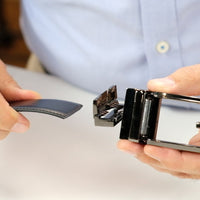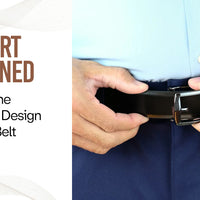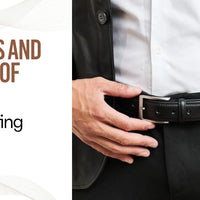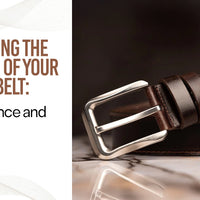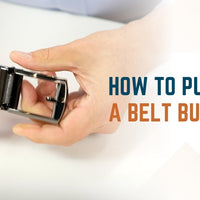Summary
- Measuring your waist accurately helps you shorten a leather belt for a perfect, comfortable fit.
- Removing the buckle carefully allows you to trim excess length without damaging the belt.
- Cutting from the hole end is a quick fix for casual belts needing small adjustments.
- Refinishing the cut edge with conditioner keeps your belt looking neat and professional.
- SureFit Belt’s no-hole design simplifies fitting without needing to cut or punch holes.
A leather belt that’s too long can look messy, slip off, or feel awkward, throwing off your whole outfit. Over time, belts can stretch, or you might buy one that’s just too big, making it hard to wear comfortably. Shortening your belt at home gives you a custom fit without the cost of a new one, keeping your style sharp and your wallet happy. With a few simple tools, you can trim it yourself, or a professional can do it for a perfect finish.
This guide covers two easy ways to shorten a belt cutting from the buckle end or the hole end so you can get a fit that feels just right. Follow these steps to make your leather belt fit perfectly and look great.

Step-by-Step Methods to Shorten a Leather Belt
Method 1 – Shortening from the Buckle End (Best for Significant Adjustments)
If your belt is much too long but you want to keep the hole layout, cutting from the buckle end works best. Start by taking off the buckle, use a screwdriver or drill to remove any screws or rivets holding it in place, being gentle to avoid tearing the leather.
Wear the belt and mark where it feels snug, then measure how much to cut off, usually 1–2 inches past your ideal fit. On a solid surface like a wood board, use a utility knife and a straight edge, like a ruler, to cut cleanly. Reattach the buckle with new Chicago screws or rivets for a strong hold. If you need new holes for the screws, use a punch or awl to make them neat.
Method 2 – Shortening from the Hole End (Simpler, Less Invasive)
For a fast fix with fewer tools, cut from the hole end, perfect for casual belts needing small tweaks. Put on the belt and mark the spot where it fits best, usually where it’s snug but not tight. Use a sharp utility knife or razor blade on a solid surface, lining up a carpenter’s square for a straight cut. Smooth the raw edge with an edge beveller, fine sandpaper, or a damp denim cloth rubbed gently to burnish it. If your belt uses holes, punch new ones about 1 inch apart with a leather punch to keep the spacing even.
Basic Leatherworking Tools
To shorten a belt, you need a measuring tape or ruler to find the right length accurately. A utility knife or razor blade ensures a clean, precise cut. If your belt has holes, a leather hole punch is essential for adding new ones. A screwdriver or drill removes buckle screws or rivets safely. Use a solid cutting surface, like a wood board, to protect your tools and get a straight cut. For finishing, an edge beveller, leather conditioner, or fine sandpaper smooths the cut edge, keeping it neat. These tools are easy to find at craft stores or online, and many households already have a ruler and screwdriver.
Pre-Cutting Preparation
Assess the Belt Fit
Put on your belt and find the spot where it feels best snug but not tight. Mark this spot with chalk or a marker, then measure from the buckle to this point. Add 1–2 inches for comfort and overlap. Check the excess length you need to remove, and double-check by wrapping the belt around your waist again. If you’re shortening a dress belt, make sure the cut won’t affect its polished look. For casual belts, you have more wiggle room, but precision still matters to avoid a sloppy finish.
Practice First (Recommended)
Cutting leather can be tough if you’ve never done it, and a bad cut is hard to fix. Grab an old belt or a piece of scrap leather to practice first. Test how much pressure your knife needs and practice cutting straight lines with a ruler. Try punching holes or burnishing edges to get a feel for the tools. This helps you avoid mistakes on your good belt and builds confidence for a clean, professional result.
Post-Cut Adjustments & Final Touches
Check the Fit
After cutting, put the belt on to test the fit before punching holes or reattaching the buckle. It should feel snug but let you move comfortably. If it’s still too long, trim small bits, like a quarter-inch at a time, to avoid over-cutting.
Refinish the Edge
A rough cut edge looks messy and can fray. Smooth it with an edge beveller or burnish it by rubbing with a damp cloth in small circles. Apply leather conditioner to the edge to keep it from drying out or peeling, giving your belt a neat, polished look that matches its original style.
Punching New Holes (If Necessary)
If you cut from the hole end and need holes, mark new ones about 1 inch apart for even spacing. Use a rotary or single-size leather punch to make clean holes. Check that they line up with the buckle for a smooth fit.
Care & Maintenance After Shortening
Daily Maintenance
Wipe your belt with a damp cloth after each wear to clean off dust, sweat, or dirt. Avoid soaking it, as too much water can weaken the leather, causing cracks or fading that ruin its look over time.
Monthly Conditioning
Apply a small amount of leather conditioner every month to keep the leather soft and prevent cracks. Focus on the cut edge, as it’s more likely to dry out or peel after trimming, ensuring the belt stays strong and smooth.
Proper Storage
Roll or hang your belt loosely to avoid creases that can damage the leather. Store it in a cool, dry place, away from sunlight or heat sources like radiators, to prevent fading, warping, or drying out.
FAQs
Can all leather belts be shortened?
Most real leather belts can be shortened, unless they’re permanently stitched in a way that can’t be undone.
Is it better to shorten from the buckle end or hole end?
The buckle end looks cleaner for formal belts; the hole end is easier for casual belts.
What tools are absolutely necessary?
You need a utility knife and measuring tape at minimum to shorten a belt.
Can I use scissors instead of a knife?
Only use industrial-strength scissors; regular ones can damage the leather and make uneven cuts.
Final Thoughts
Shortening your leather belt is a simple way to get a perfect fit that makes you look and feel great. With the right tools and careful steps, you can trim it at home, saving money and keeping your style on point.
Make sure to always measure twice to avoid mistakes, cut slowly for a clean edge, and condition the leather afterward to make it last for years. Whether you’re fixing a casual belt for jeans or a dressy one for suits, a well-fitted belt boosts your confidence and pulls your outfit together.
Moreover, if you want a belt that fits perfectly without any cutting, SureFit Belt’s no-hole, adjustable design fits waists from 28 to 46 inches right out of the box. Its reversible black and brown leather works for any occasion, making it a smart, hassle-free choice.
Visit SureFir Belt for a premium belt that gives you a custom fit with zero effort.
Read More Articles:



